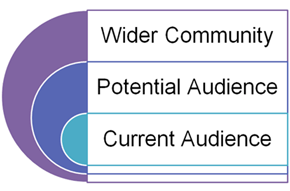Inside Out vs. Outside In: Community engagement and loyalty building work together
Guest Post by Amelia Northrup-Simpson, TRG Arts
This post is part of a series of collaborations with TRG Arts and is cross-posted to their blog Analysis from TRG Arts.

Photo by Pam Corey (CC BY-NC-ND 2.0)
There are two schools of thought when it comes to eating a cinnamon roll.
There are those who eat the cinnamon by unrolling it, eating along the edge, slowly making their way to the gooey, sugary middle.
Then there are those want to get to the middle as soon as they can. Flaky crust is all well and good, but the cache of frosting and sticky cinnamon goodness is too good to resist.
Neither approach is right or wrong, but they are different.
These differing styles are a fair comparison to how organizations approach arts marketing.
 The community of people that your organization might serve can be divided into 3 categories:
The community of people that your organization might serve can be divided into 3 categories:
- The wider community: those who may or may not be inclined to attend but don’t.
- Your potential audience: those who are inclined to attend but don’t.
- Your current audience: those who are inclined to attend and do.
When it comes to developing arts audiences, practitioners tend to take one of two approaches.
Community engagement advocates start at the flaky outside of the cinnamon roll and work in. In other words, they start in the wider community and encourage people to become current audience members.
Patron loyalty advocates are all about that mother lode of frosting and cinnamon in the middle. They focus on the current audience, shore up revenue and support there, and then work their way out.
Each approach has its place. How do you know best approach for your organization? It all depends on where your organization is and where it wants/needs to go.
Some organizations are in the financial position where they must grow working capital by the best and fastest means possible. Usually, this involves focusing on current patrons—retaining and upgrading them. Deepening already existing or already strong relationships yields high ROI, which is critical for organizations with time-crunched staff and tight budgets.
Other organizations should invest more fully in engaging more broadly throughout the community. Maybe they are already doing a great job retaining patrons and are ready to prospect more broadly. Maybe their mission or organizational objectives require them to do both at the same time. Broadening and diversifying audiences are important goals for any organization to have. New patrons not only replace the ones we lose each year, but shape the future of our organization. But remember, new audiences also have to be cultivated alongside existing ones.
Whether you’re considering trying to engage a broader community, bring more diversity to your audience, change the programming that you present, or contemplating new revenue streams and business models, those changes take investment—of money and time. The capital can come from your current audience or could be provided by a grant, but regardless of source, organizations need capital to fund initiatives that engage the community. You’ve got to be able to cash-flow the bright future that you’re trying to create, or risk losing your organization’s future altogether.
———————————————————-
 Amelia Northrup-Simpson has devoted her career to bringing audiences and artists together. As frequent writer and speaker on building sustainable arts organizations, developing and engaging arts audiences, and patron technology expectations, she helps arts managers cut through noise and distractions to focus on the most effective marketing and technology strategies for their organization.
Amelia Northrup-Simpson has devoted her career to bringing audiences and artists together. As frequent writer and speaker on building sustainable arts organizations, developing and engaging arts audiences, and patron technology expectations, she helps arts managers cut through noise and distractions to focus on the most effective marketing and technology strategies for their organization.
Currently, Amelia is the Director of Strategic Communications at TRG Arts, a consulting firm which focuses on getting audience development and revenue results from loyalty, pricing, and data strategies. She serves as an editor and writer for the firm’s consulting and research analytics projects, presentations and webinars, case studies, and the TRG blog Analysis from TRG Arts. She also serves as TRG’s in-house marketing technologist and user interface advisor. She has presented conference panels, workshops, and webinars for Americans for the Arts, Theatre Communications Group, Do Good Data, Chorus America, and Colorado Creative Industries, among others. She is a member of the artsmarketing.org Advisory Committee and serves as adjunct faculty at University of Denver’s Arts Development and Program Management master’s degree program.

I enjoyed this post. What I also find interesting is that arts organizations must also constantly have that “Come-to-Jesus” moment with themselves in deciding exactly what they should be aiming for certain audiences to do as a result of certain marketing/engagement efforts. I have seen many organizations take the position of marketing to the wider audience in hopes that they ALL become potential subscribers. But as we know, not all audiences will realistically become subscribers, so success should not only be defined in terms of ticket sales. Therefore, I believe coming up with “what success looks like” for the various audiences you pointed out in the post is also very important.